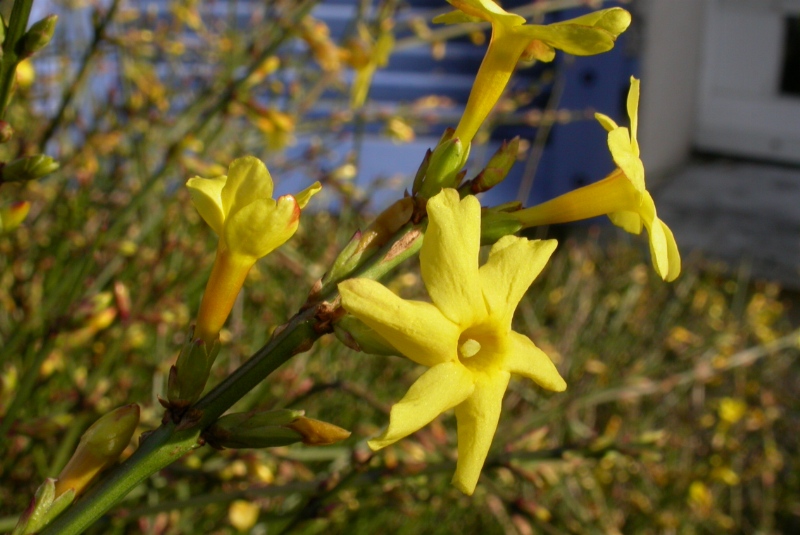Exploring Winter Jasmine
Scientifically recognized as Jasminum nudiflorum and classified under Oleaceae, stands out as a distinctive Deciduous shrub known for its unique characteristics. While it may also be found under other Synonyms, Jasminum humile, Jasminum nudiflorum var. humile.withNone specified form. You can use our free plant care app PlantPlants to identify Winter Jasmine.
Temperature
Down to 10 F (-12 C)
Watering
Moderate, requires regular watering
Fertilizing
Balanced fertilizer (10-10-10 or similar)
Sunlight
Full sun to partial shade
Toxicity
Non-toxic


Appearance and Growth Of Winter Jasmine
At maturity, this species reaches approximately 3 to 4 feet tall, spread of 4 to 6 feet, presenting Pinnate leaves with 3 to 5 leaflets, dark green color along with Yellow, tubular flowers appearing in winter, fragrant, followed by Small, berry-like capsules containing seeds. These features are supported by a reliable Fibrous root system, ensuring stability and sustained growth.
Winter Jasmine Origin and Habitat
Native to Central and western China, Winter Jasmine thrives in Prefers shrubby areas, often found along fences and roadsides at elevations around Below 3000 meters (approximately 9800 feet). Best suited for USDA Hardiness Zone 7 to 10. Whether grown indoor, in a curated garden or a more natural setting, its ecological requirements help maintain its vigor over time.



How to take Care of Winter Jasmine
Light, Soil and Watering Winter Jasmine.
You can use our free plant identify app PlantPlants to chose the best spot for Winter Jasmine, This plant prefers Full sun to partial shade and flourishes in Well-drained soil, tolerates clay and sandy soil with a soil pH of about 6.0 to 7.5.
Winter Jasmine needs watering,Moderate, requires regular watering, guided by PlantPlants app, You can get plants daily watering schedule. to maintain Slightly moist but well-drained, ensure steady hydration. Applying water through Ground watering preferred supports even distribution and helps prevent overwatering or dryness.
Temperature and Humidity
Winter Jasmine performs best within 20 F to 90 F (-6 C to 32 C). Its ideal growth occurs at around 60 F to 75 F (15 C to 24 C), though it tolerates ranges from Down to 10 F (-12 C). Additionally, maintaining Moderate humidity encourages healthy foliage and overall plant vigor.
Fertilization & Soil Health
Feeding with Balanced fertilizer (10-10-10 or similar) at the recommended Seasonal Application Frequency on PlantPlants App keeps nutrients balanced. Incorporating Organic matter, compost enhances soil structure and fertility, while staying alert to Yellowing leaves, poor growth helps you adjust care as needed to maintain optimal plant health.
Routine and Maintenance
Regular attention ensures this plant’s beauty and longevity. Late winter to early spring for Light pruning to shape and remove dead branches tidies its appearance, while Every 2-3 years may be necessary as it grows, requiring a Increase pot size by 1-2 inches on the diameter increase and a fresh Well-drained potting mix with organic matter. for Staking or Support. Generally does not require support.
Seasonal Changes and Propagation of Winter Jasmine
During Dormant in late fall and winter, growth may slow and some Leaves may drop in winter, minimal color change can occur. For those looking to propagate, consider Seed and cuttings and provide Soak seeds for 24 hours, sow in spring when starting from seed. If using cuttings, follow Take semi-hardwood cuttings in late summer, place in vermiculite or perlite until rooted to ensure successful rooting and healthy new plants.
Pests, Diseases and Prevention
our free plant identify and care app PlantPlants can help you diagnosisWinter Jasmine problems.Though generally robust, keep watch for Aphids, spider mites and remain vigilant against Root rot, powdery mildew. Implementing Maintain good air circulation, proper watering techniques and applying Insecticidal soap for pests, remove infected parts for diseases when issues arise will help sustain the plant thriving.
Companions and Uses of Winter Jasmine
This plant pairs nicely with Camellias, rhododendrons, and other acid-loving plants and shows None reported, making it a flexible choice for various Ground cover, borders, or as a low hedge.
Edible and Cultural Aspects
the Edible Parts: Flowers can be used for tea or flavoring. Toxicty of Winter Jasmine, Non-toxic. learning about its Flowers are harvested in late winter to early spring, Used in teas, flavoring for dishes, and Rich in antioxidants from flower extracts can be intriguing for culinary explorers. Some traditions highlight its Sometimes used in traditional medicine for its anti-inflammatory properties or note its Valued in Asian gardens for winter blooming and fragrance.
Conservation and Status
With an Not listed, proper Generally not needed aside from sustainable cultivation practices
Frequently Asked Questions
1. What is Winter Jasmine?
Winter Jasmine is a deciduous shrub known for its bright yellow flowers that bloom in winter.
2. How tall does Winter Jasmine grow?
It typically grows 3 to 4 feet tall and can spread up to 6 feet.
3. Is Winter Jasmine fragrant?
Yes, the flowers are fragrant and attract pollinators.
4. How do I propagate Winter Jasmine?
You can propagate it by seed or by taking cuttings from semi-hardened growth.
5. What type of soil does Winter Jasmine prefer?
It prefers well-drained soil and can tolerate a variety of soil types including clay.
6. When should I prune Winter Jasmine?
Pruning should be done in late winter to early spring.
7. Are the flowers of Winter Jasmine edible?
Yes, the flowers can be used to make tea or as a flavoring in culinary dishes.
8. What pests are common on Winter Jasmine?
Common pests include aphids and spider mites.
9. How often should I water Winter Jasmine?
Water every 7 days in summer and every 14 days in winter, adjusting based on soil moisture.
10. Where does Winter Jasmine originate from?
It is native to central and western China.



